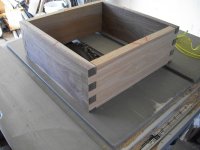Mario Turcot
Member
- Joined
- Nov 26, 2017
- Messages
- 1,288
I am looking to incorporate finger joints and dove tails joinery to some incoming projects. I want to use something that will be somehow easy to setup and quick. Time is a huge factor and I don't want to spend days building table/jigs.
Here the options;
- Hand joinery, too much of a learning curve right now.
- Table saw and Incra iBox. Any other brand I should look for?
- Router table and accessories. Brand?
- Leight Jigs, would the OF 1400 fit well?
- Other options?
Thanks in advance, Mario
Here the options;
- Hand joinery, too much of a learning curve right now.
- Table saw and Incra iBox. Any other brand I should look for?
- Router table and accessories. Brand?
- Leight Jigs, would the OF 1400 fit well?
- Other options?
Thanks in advance, Mario


